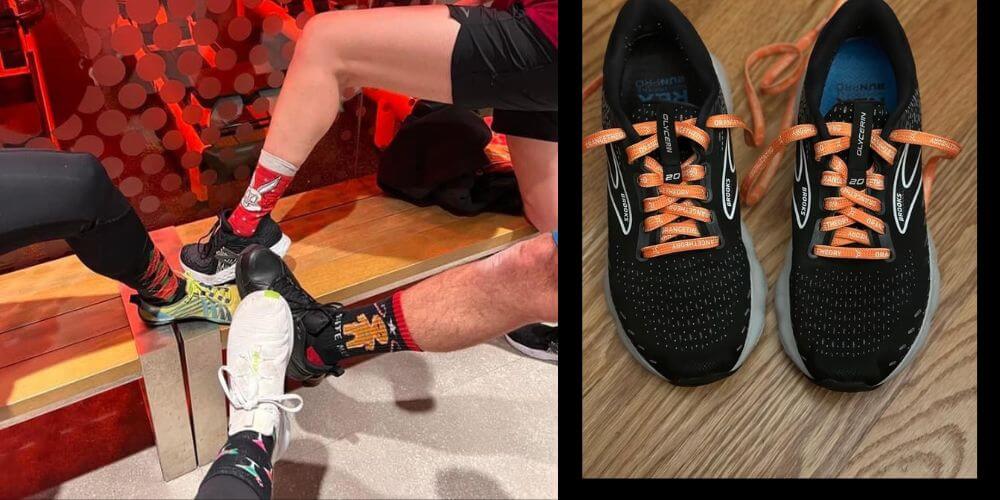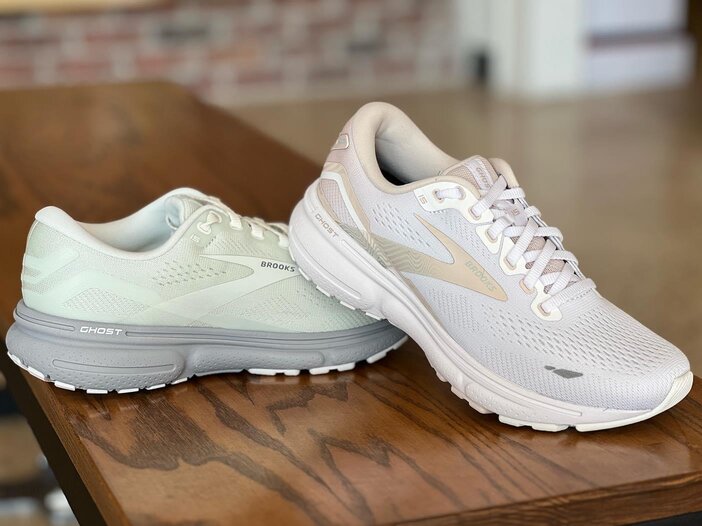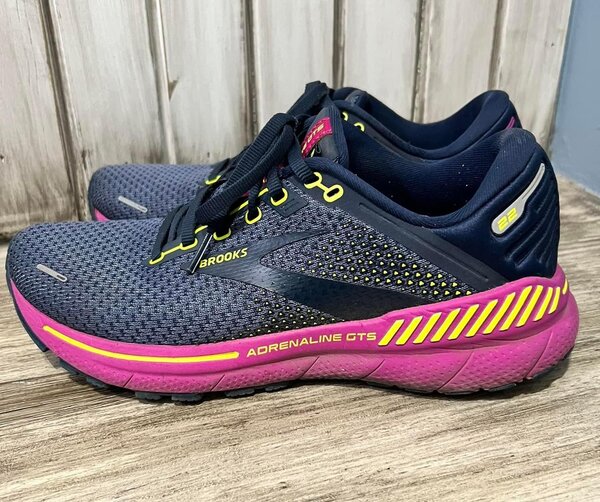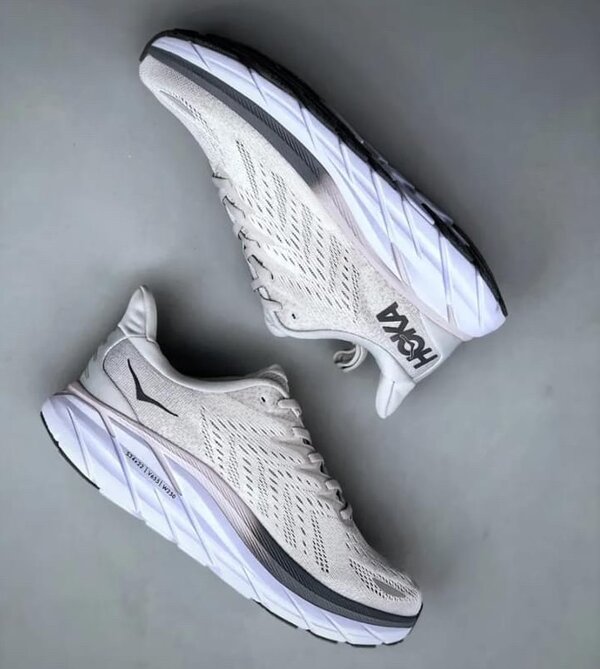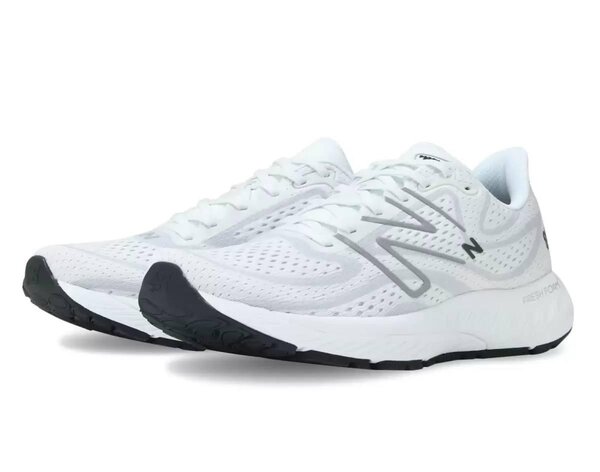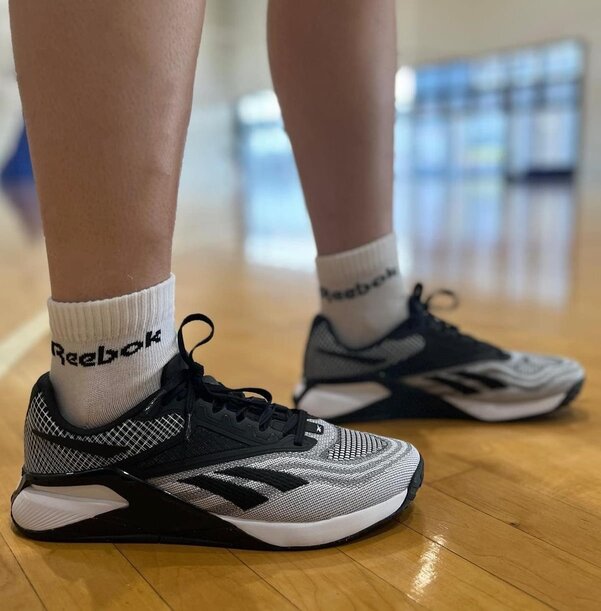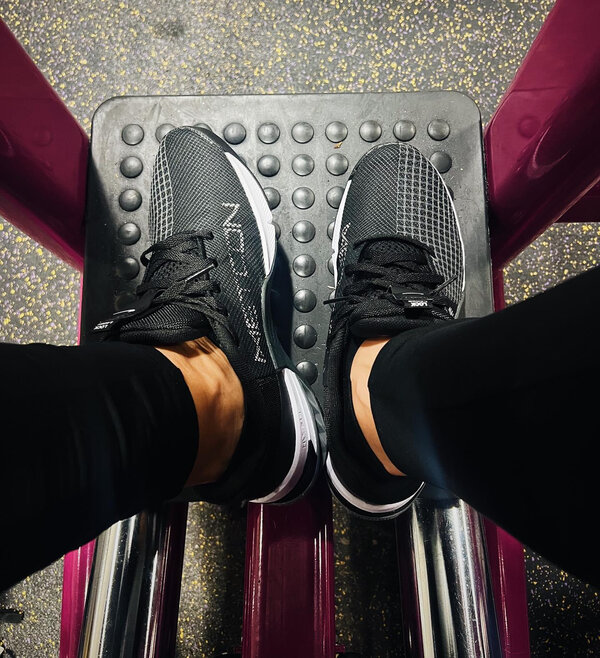Orangetheory has two types of classes. One is orange 60: 2G/3G (that is Orangetheory regular class), and the other is Strength-50, which is a total strength program. Orangetheory 60 class combines a general set of three exercises(treadmill, rowing, and floor strength training) for a maximum of 60 minutes. For these various workouts, one may wonder what type of shoes to consider for Orangetheory, especially between running and cross-training shoes.
Which One is the Best Shoes for Orange theory : Running Shoes or Cross-Training Shoes?
For orange 60 classes: I recommend a true running shoe. Shoes for rowing could be anything, and the floor work isn’t so much that you need special shoes, but the treads will continually put stress on ankles and knees. Get something that’s designed to ease the wear and tear. Most running shoes are also good for agility and HITT workouts, so it’s perfect for orange 60 (2G/3G Class). I just want my running shoes unless it’s specifically a lift class.
For Strength-50: Lifting (especially squats and deadlifts) in running sneaks is recipe for disaster. I actually wear Nike Metcons on the rower and floor and change to running sneakers. In the Strength-50 class, complete floor exercises and weight-lifting workouts. Running shoes are good for orange 60 classes, but they have too much cushion and not enough stability. Strength-50 classes need flatter-type shoes. I feel more grounded in flatter shoes and easier to push down on my feet (if that makes sense) when I lift heavy.
I have been doing OTF for 4 years now. I’ve tried a bunch of different shoes, and this is what I’ve found. Running shoes generally lack the lateral stability needed for the floor. More lifting-focused shoes (Metcons, Nanos, etc.) don’t have enough cushioning/sole flex for the longer tread runs.
So, Should one have at least two pairs of shoes, a running pair, and a cross-training option? Actually, you can opt for two pairs of shoes, each for each session. Alternatively, you can opt for one pair that works for both.
Note: You need to research your shoe. Please don’t just buy cause it’s what everyone is wearing; high arches need a neutral type shoe, and low arches or flat arches need a stability shoe. For high arches: Invest in orthotics, then wear a neutral shoe. Your feet will love you.
And prioritize finding shoes that offer support, breathability, grip, and light cushioning.
Best Running Shoes for Orange theory 60: 2G/3G (Regular Class)
- Brooks Ghost 15 – Neutral Running Shoes
- Brooks adrenaline – Shoes are for people who need stability
- Hoka One Clifton 8 – Running Shoes
- On cloud X – Lightweight shoes
- New Balance 880 – Neutral cushioned running shoe
Best For wide feet
- Brooks Ghost 15 – Neutral running Shoes
- Brooks adrenaline – Stability Running Shoes
- New Balance 880 – Neutral running shoe
Best Shoes For The Strength-50 Classes
Best Sneakers for Orangetheory for Both Weight Floor and Running
Related: What to Wear to Orangetheory (OTF Dress Code)?
Keep scrolling to discover all the shoe details for men and women,
Best Running Shoes for Orange theory 60 (Regular Class)
Orange 60 is the most common Orangetheory class, and it spreads the workouts among the treadmill, rowing machine, and floor exercises.
Below are shoes that you can wear for Orange 60 without having to change mid-session;
1. Brooks Ghost 15 – Neutral Running Shoes
Specifications
- Best for: Running
- Hell-to-toe drop: 12mm
- Weight: 255.1g
- Support/ neutral: neutral
- Sizes: 7- 15 (narrow to x wide)
- Colours: 20
Just as the name suggests, Ghost 15 neutral offers neutral support to the feet, hence great for running, rowing as well as floor cross-training exercises. You will get sufficient support and enough cushioning necessary for all your Orangetheory exercises.
Moreover, the shoes are a refined 3D Fit Print construction, which offers a secure and comfortable fit. Actually, they are PDAC A5500 Diabetic certified and given the APMA Seal of Acceptance. Then there is the soft midsole that couples with integrated shock absorbers to enhance a stable yet comfortable landing. With an air mesh upper that facilitates breathability and moisture-wicking, the shoe is definitely an excellent choice for OTF.
Pros
- Comfortable for running as well as short cross-training sessions.
- Multiple widths, sizes, and color options
- Breathable and moisture-wicking upper.
Cons
- Limited colors for narrow and wide size options.
2. Brooks adrenaline – Shoes are for people who need stability
Specifications
- Best for: Running
- Heel-to-toe drop: 12mm
- Weight: 258 g
- Support/ Neutral: support
- Sizes: 7 narrow to 15 x wide
- Colors: 29
Brooks Adrenaline GTS 22 lives up to its name as an ‘adrenaline’ because it will really help improve your speed and running duration. It has optimal support from the medium cushioning it gets from Brooks GuideRails technology.
Due to the medium cushioning, it is still suitable for short-time cross-training and rowing sessions because they offer the right amount of stability and grip. The updated DNA LOFT cushioning and a segmented crash pad combine to prevent you from landing toe-off.
Therefore, it is a perfect option for Orangetheory’s 2G classes that have longer treadmill sessions while still incorporating shorter floor and rowing sessions.
Pros
- Comfortable and secure fit.
- Great for improving speed and running convenience due to optimal support.
- Lightweight.
- Support for knees and feet, and best for plantar fasciitis and Achilles tendinitis.
Cons
- The inner lining wears off quite fast
3. Hoka One Clifton 8 Running Shoes
Specifications
- Best for: Running and cross-training
- Heel-to-toe: 5mm
- Weight: 252 g
- Support/ neutral: neutral
- Sizes: 7.5 to 10.5
- Colors: 28
Hoka One Clifton 8 is designed with stability in mind, meant to prevent toe-off landing. While they are great at enhancing running speed, they can also accommodate cross-training, hence Orangetheory-friendly. The full-length EVA midsole easily absorbs shock, offering stability and added cushioning. An extended heel crash pad facilitates an even safer landing regardless of the exercise intensity, especially with running.
The shoes’ design has a breathable construction, with an open mesh upper that couples with a breathable textile lining. Then there are rubber inserts that facilitate grip while enhancing comfort.
Pros
- Highly breathable.
- The stability that couples with appropriate cushioning.
- Comfortable.
- Suitable for multiple gym activities.
Cons
- There are no width options.
4. On cloud X – Lightweight shoes
Specifications
- Best for: running and other gym exercises
- Heel-to-toe: 6mm
- Weight: 200 g
- Support/ neutral: low
- Sizes: 7.5 to 14
- Colors: 4
Amazingly, the Cloud X comes in a round toe and cushioned footbed for excellent comfort and to prevent hot points in strenuous exercises.
Cloud X running shoes are agile and versatile, allowing you to take on any exercise without discomfort. They are the shoes you need to strike a balance among running, rowing, and cross-training in Orangetheory. The shoes boast high stability and are lightweight, which almost all gym exercises will demand.
With a mesh upper and a lace-up closure, the shoe keeps your feet from hot spots and a soggy feel. Adding a dual-density sock liner, a soft shoe tongue, and interior material, your comfort is well-considered in the shoe design.
Most importantly, the shoes have a Zero-Gravity foam that absorbs shock from all directions and furthers stability during cross-training.
Pros
- Suitable for most gym exercises.
- Breathable and moisture-wicking.
- They offer optimal stability and landing comfort.
Cons
- There are no width options.
5. New Balance 880 – Neutral cushioned running shoe
Specifications
- Best for: running
- Heel-to-toe: 10 mm
- Weight: 237 g
- Support/ neutral: support
- Sizes: 4 to 18.5 (narrow to x-wide options for sizes 5 to 13)
- Colors: 17
The Foam X880 V12 is a top choice for OTF users with treadmill-specific shoes. The dual-layer midsole construction, which has a top-bed foam and the underfoot Foam X, facilitates optimal cushioning for running. With a 10 mm drop, landing off-toe is minimized.
Other than that, the upper is a neat double-knit mesh that facilitates breathability and comfort during exercise.
The shoes are available in a colossal number of sizes, most of which have narrow, wide, and x-wide options as well.
Pros
- Sufficient cushioning for optimal running performance.
- Excellent landing stability.
- Comfortable and breathable.
Cons
- Few color alternatives.
Best Shoes for Orangetheory Strength-50
While it is understandable to use running shoes in all stations in Orange 60, Strength-50 can be challenging. Strength-50 focuses on resistance and weight-lifting with absolutely no cardio exercise!
For this reason, you will require good cross-training shoes, which will usually be lightweight, flatter, and with less cushioning compared to running shoes. Most importantly, they offer grip and sufficient stability suitable for even deadlifts and weight squats.
Best shoes for Strength-50 Orangetheory include the following:
1. Reebok Nano X2
Specifications
- Good for: cross-training and running
- Heel-to-toe: 7mm
- Weight: 10.2 oz
- Sizes: 5 to 14 (with half sizes)
- Colors: 19
The Nano X2 Cross Trainer will take you through squats and burpees and help you with all weightlifting exercises, hence suitable for Orange Strength-50. The rubber outsole has a lug pattern, which colludes with midfoot teeth to facilitate traction and stability. They are also a versatile pair that allows for running, so you can consider it for your Orange 60 as well if you take both class options.
The construction is Flexweave knit upper, which is durable and secure for multidirectional movements. It is also breathable enough to prevent hot spots.
Pros
- Sufficient breathability
- Reliable traction and stability
- Versatile for multiple exercises.
- Highly durable material
Cons
- The laces are pretty short
2. Nike Metcon
Specifications
- Good for: cross-training and running
- Heel-to-toe drop: 4 mm
- Weight: 283 g
- Sizes:3.5 big kid to 9.5
- Colors: 7
Nike Metcon 5 is an exquisite option for cross-training, while its reasonably flexible forefront allows for short runs, therefore, whether you are up for deadlifts or burpees.
Basically, the shoes have a flat and wide heel that facilitates stability. Besides that, they come with a removable Hyperlift insert, which helps with comfort and stability with thrusters, wall balls, and squats.
With an outsole that wraps up the side of the shoe, you get directional traction and grip sufficient for improved climber stability.
Pros
- They offer maximum grip and traction for stability.
- Highly durable.
- Lightweight and comfortable.
Cons
- They run small for people with wider feet.
Best Sneakers for Orangetheory for Both Weight Floor and Running
Running with floor training shoes will fail you with insufficient cushioning, while running shoes do not have optimal stability for weightlifting. To avoid injuries and poor performance from wearing the wrong shoes, you can consider buying two pairs for Orangetheory; one for running and another for rowing and floor workouts. Alternatively, some shoes allow you to strike a balance between the two exercises, especially when you do the exercises in a short time.
Let’s look at the most outstanding shoe options for running and weight lifting in Orangetheory;
1. Nike Zoomx Superrep Surge – Perfect for treadmill to rowing machine to strength training
Specifications
- Best for: strength, rowing, and treadmill exercises
- Weight: 187 g
- Sizes: 5 to 11 (with half sizes)
- Colors: 6
Interestingly, Nike’s Superrep Surge is exactly suited for all Orangetheory workouts. You can take on a treadmill, floor exercises as well as the rower efficiently.
Essentially, it features an energy-return foam that facilitates a springy landing during treadmill classes. The rubber tread outsole facilitates traction on the floor, while the side arc support facilitates ease of transitioning during HIIT strength classes. To crown it all, a rower clip at the heel helps transition on the rower. Then, a mesh across the shoe holds up against the foot straps.
Pros
- Versatile for all Oranegtheory exercises.
- Breathable and moisture-wicking.
- Lightweight.
Cons
- Runs small in size.
2. Reebok Crosstrainers
Specifications
- Best for: combination training and running
- Heel-to-toe drop: 7mm
- Weight: 12.1 oz
- Sizes: 4 men/ 5.5 women to 15 men/ 16.5 women
- Colors: 38
The Nano X1 cross-trainer is an excellent sneaker for all cross-training exercises. It enables you to jump, throw the barbell, climb and make all forms of strength training movements.
Essentially, the shoes are lightweight and with substantial foam cushioning while providing optimal stability on the floor. And with a shock-absorbing EVA midsole, the shoes can handle all levels of cross-training exercise intensities.
Furthermore, the shoes combine durability and breathability, providing comfort and integrated support and excellent for the treads and fabulous support for floor work…the sole is also great for transitions in and out of the rower.
Pros
- Breathable and comfortable.
- They provide optimal stability and integrated support.
- Lightweight for all cross-training exercises.
Cons
- There are no width options.
3. Reebok Dynamica Zig
Specifications
- Best for running
- Weight: 200 to 250 g (depending on size)
- Sizes: 5 to 11 (with half sizes)
- Colors: 34
The Zig Dynamica for women are running sneakers but have a flat bottom that facilitates stability during cross-training sessions. The signature Reebok zigzag midsole further enhances the stability for different floor exercises.
Additionally, the shoes are lightweight for comfort and performance when on the treadmill and for floor training. With a plush sock liner, the shoes are moisture-wicking and comfortable for long-period exercises. Besides, they are a mesh construction on the upper side, facilitating breath-ability and preventing hot spots.
Pros
- Highly breathable.
- Lightweight and comfortable.
- Moisture-wicking for longer periods of comfort.
Cons
- Run narrow at the toe box.
For High Arches
Admittedly, neutral shoes are great, and some athletes prefer them to supported shoes. However, people with high arches definitely feel uncomfortable in neutral shoes and often give up the efficiency of these shoes for the convenience of supported shoes.
Nonetheless, you can always go for Orthotic Support inserts, which allow high arches to enjoy the efficiency and performance of neutral shoes.
Let’s have a look at the most outstanding inserts for high arches you should consider;
1. Superfeet GREEN – High Arch Orthotic Support

The Superfeet Green inserts are high-density foam, providing high arch support for optimal support.
They are durable and can last approximately 12 months, allowing you to run for at least 500 miles.
The best part is that they fit most roomy shoe styles with removable insoles. You can also consider going for a shoe size higher to give room for the inserts. They will save you from common foot pains, plantar fasciitis and heel pain, which limits your running sessions.
Besides inserts, you can consider buying supported shoes such as the Clinton 8 and Brooks Glycerin.
Flat arch Shoes
If you have flat arches, you will need stability shoes for Orangetheory training to prevent pain from the challenging exercises. ASICS Women’s Gel-Kayano 28 Running Shoes is an excellent pair, which optimal stability and support from an increased platform. With its reduced weight and high abrasion rubber outsole, the running shoes will also pass for the short Orangetheory training sessions.
Best Orangetheory Shoes for Wide Feet
Sadly, it is challenging to get appropriate-fitting shoes when you have wider feet. However, we have recommendations that offer shoes for wide feet with width options of up to x-wide. Brooks Adrenaline GTS 22 Supportive Running Shoe is the best option for both men and women with wide feet.
What to Look for and What to Avoid in Your Orangetheory Sneakers.
In most cases, you get training shoes designed for running or cross-training. However, since Orangetheory is more of both, getting a shoe that gives you the best of both worlds is more convenient.
What to look for in the training shoes will include the following;
- Comfort: whether you consider running or weight-lifting shoes, Orangetheory lasts for at least 45 minutes, during which your feet and body should be comfortable. A comfortable pair of shoes should be fitting, breathable, and moisture-wicking for maximum comfort over the one hour of HIIT OTF workouts.
- Performance: You will need shoes with a stable base for optimal support for weight lifting. However, treadmill running requires shoes with a flexible outsole to ease running and avoid injury.
- Weight: Look for lightweight shoes for Orangetheory, as the lightweight helps with the flexibility and comfort required in all the OTF exercises.
- Sufficient padding: Running shoes will always have a lot of padding for cushioning, while cross-training shoes should have a moderate amount of padding. Since Orangetheory single exercises don’t take long, you can use either air for the exercises or change mid-session for optimal comfort.
- Outsole: running shoes will have a high heel-to-toe drop outsole due to the padding needed for flexibility and a springy effect. However, cross-training shoes have a low heel-to-toe drop for better stability on the floor. Overall, both shoes should have a level of a grippy outsole to enhance safety and stability.
What to avoid in OTF shoes will include the following;
- Shoes that are too flexible: while flexibility is necessary for OTF shoes, too much as in walking shoes will be bad for cross-training as well as rowing sessions.
- Heavy shoes: while you need grip with cross-training and cushioning with running shoes, you don’t need heavy shoes. Cross-training shoes can be low-profile with minimal cushioning and be extremely comfortable. Running shoes of high-quality cushioning material will also be lightweight yet great for the spring experience you need on the treadmill.
Conclusion
The best shoes for Orangetheory can be challenging since OTF combines cardio exercises with strength training, which requires different shoes. However, users have the liberty to change shoes depending on the station. Even better, some shoes are actually good for all Orangetheory exercises. Besides, the exercises, especially in Orange 60, are short per station.

